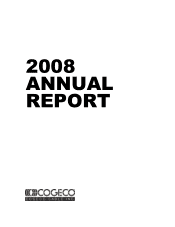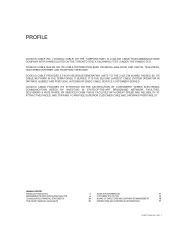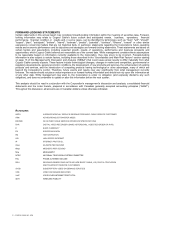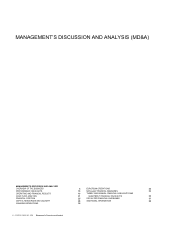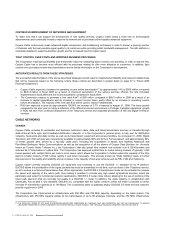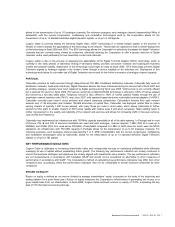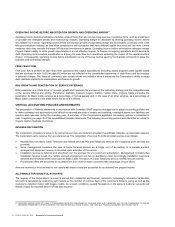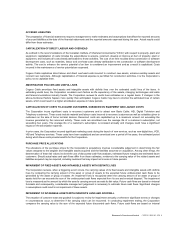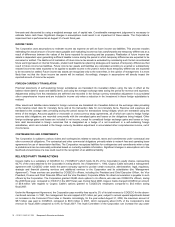Cogeco 2008 Annual Report Download - page 10
Download and view the complete annual report
Please find page 10 of the 2008 Cogeco annual report below. You can navigate through the pages in the report by either clicking on the pages listed below, or by using the keyword search tool below to find specific information within the annual report. Management’s Discussion and Analysis COGECO CABLE INC. 2008 9
ACCRUED LIABILITIES
The preparation of financial statements requires management to make estimates and assumptions that affect the reported amounts
of accrued liabilities at the date of the financial statements and the reported amounts expensed during the year. Actual results could
differ from those estimates.
CAPITALIZATION OF DIRECT LABOUR AND OVERHEAD
As outlined in the recommendations of the Canadian Institute of Chartered Accountants (“CICA”) with respect to property, plant and
equipment, capitalization of costs includes the expenditures to acquire, construct, develop or improve an item of property, plant or
equipment, and includes all costs directly attributable to those activities. The cost of an item includes direct construction or software
development costs, such as materials, labour and overhead costs directly attributable to the construction or software development
activity. The cost to enhance the service potential of an item is considered an improvement and as a result is capitalized. Costs
incurred in the maintenance of service potential are expensed.
Cogeco Cable capitalizes direct labour and direct overhead costs incurred to construct new assets, enhance existing assets and
connect new customers. Although capitalization of financial expense is permitted for construction activities, it is the Corporation’s
policy not to capitalize them.
AMORTIZATION POLICIES AND USEFUL LIVES
Cogeco Cable amortizes fixed assets and intangible assets with definite lives over the estimated useful lives of the items. In
estimating useful lives, the Corporation considers such factors as life expectancy of the assets, changing technologies and cable
and telecommunications industry trends. The Corporation reviews its useful lives estimates on a regular basis. If changes in the
above-mentioned factors happen more quickly than anticipated, Cogeco Cable may have to shorten the estimated lives of certain
assets, which could result in a higher amortization expense in future periods.
CAPITALIZATION OF COSTS TO ACQUIRE CUSTOMERS, SUBSIDIES ON EQUIPMENT AND LAUNCH COSTS
The Corporation incurs significant costs to reconnect customers and to attract new Basic Cable, HSI, Digital Television and
Telephony customers. These costs include material and labour costs incurred to reconnect customers as well as subsidies given to
customers on the sale of home terminal devices. Reconnect costs are capitalized up to a maximum amount not exceeding the
revenue generated by the reconnect activity. These costs are amortized over the average life of a customer’s subscription, not
exceeding four years. The average life of a customer’s subscription is reviewed annually and changes could have a significant
impact on the amortization expense.
In prior years, the Corporation incurred significant marketing costs during the launch of new services, such as new digital tiers, VOD,
HSI and Telephony services. These costs have been capitalized and are amortized over a period of five years, the estimated period
during which these costs provide benefits for the Corporation.
PURCHASE PRICE ALLOCATIONS
The allocations of the purchase prices for the Corporation’s acquisitions involves considerable judgement in determining the fair
values assigned to the tangible and intangible assets acquired and the liabilities assumed on acquisition. Among other things, the
determination of these fair values involved the use of discounted cash flow analyses, estimated future margins and estimated future
customers. Should actual rates and cash flows differ from these estimates, revisions to the carrying value of the related assets and
liabilities acquired may be required, including revisions that may impact net income in future periods.
IMPAIRMENT OF FIXED ASSETS AND INTANGIBLE ASSETS WITH DEFINITE LIVES
The Corporation reviews, when a triggering event occurs, the carrying values of its fixed assets and intangible assets with definite
lives by comparing the carrying amount of the asset or group of assets to the expected future undiscounted cash flows to be
generated by the asset or group of assets. An impairment loss is recognized when the carrying amount of an asset or group of
assets held for use exceeds the sum of the undiscounted cash flows expected from its use and eventual disposal. The impairment
loss is measured as the amount by which the asset’s carrying amount exceeds its fair value. Future cash flows are based on internal
forecasts and consequently, considerable management judgement is necessary to estimate future cash flows. Significant changes
in assumptions could result in an impairment of these assets.
IMPAIRMENT OF INTANGIBLE ASSETS WITH INDEFINITE LIVES AND GOODWILL
The valuation of customer base and goodwill is subject to review for impairment annually or whenever significant events or changes
in circumstances occur, to determine if the carrying value can be recovered. In conducting impairment testing, the Corporation
compares the carrying value to the sum of the expected future discounted cash flows. Future cash flows are based on internal

